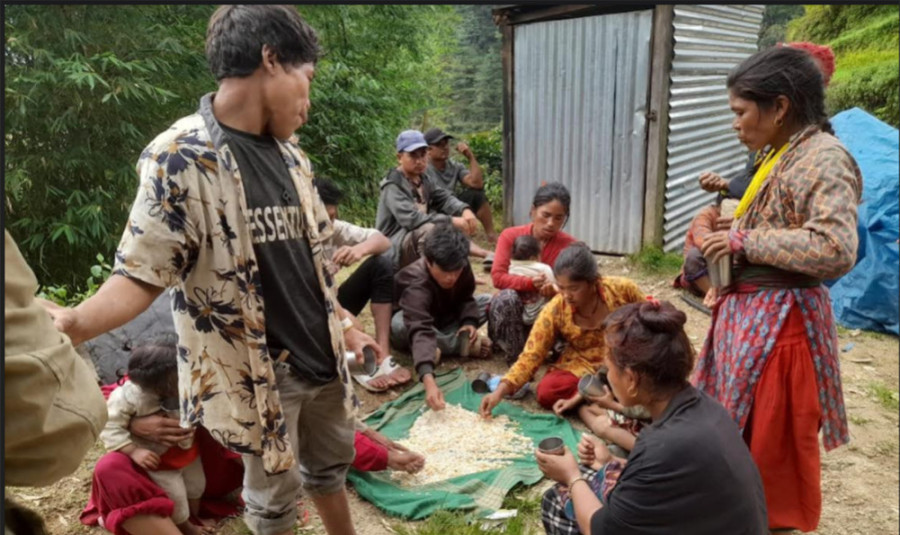National
Two weeks on, disaster victims still await promised relief
Six days after the floods and landslides, the government declared 41 local units disaster zones and announced help.
Purushottam Poudel
Nearly two weeks after the declaration of several districts and local units ‘disaster crisis zones’, the disaster victims still await the help promised by the federal government.
Floods and landslides triggered by incessant rains on September 27 and 28 caused widespread devastation in multiple districts. A few days later, the Cabinet meeting on October 4 decided to declare 41 local units of 12 districts ‘disaster crisis zones.’
However, people in the worst-hit areas are yet to get support from the federal government.
Dinesh Lama, the chairperson of Roshi Rural Municipality in Kavrepalanchok, says many local units are still waiting for help.
The government was supposed to deposit Rs10 million in local units’ disaster management funds, but the amount is yet to come, according to Lama.
“We were told that our rural municipality was on the list of disaster crisis zones, but we have yet to get help from Singha Durbar [the seat of the federal government],” Lama told the Post. “Except for the helicopter assistance to distribute relief materials in the upper parts of the municipality, we haven’t received the help we should have as a disaster crisis zone.”
Lama also claimed to have completed the rescue operation, and they are now focused on relief distribution and repairing damaged roads in the municipality.
Like Dinesh Lama of Roshi Rural Municipality, Deepa Bohara, chairperson of Sunkoshi Rural Municipality in neighbouring Sindhuli district, said their local units have also not received any help from the federal government.
“Our municipality suffered more infrastructure damage than human loss, but we are yet to get the Rs200,000 compensation announced by the government for the families of the deceased,” Bohara told the Post. “We were supposed to receive it through the District Administration Office, but we are still waiting.”
At least three people lost their lives in the floods and landslides in her municipality, Bohara said.
Deputy chair Rajan Prasad Ghimire of Konjyosom Rural Municipality in Lalitpur said the local units within the Kathmandu Valley have also not received adequate assistance from the federal government.
Our local municipality has received Rs200,000 for each bereaved family and an additional Rs15,000 for those whose houses were damaged by the rain. Beyond this, we have not received any help from the federal government.
“The federal government should have shifted those who have been rendered homeless due to the continuous rain to a safer place,” Ghimire told the Post. “The budgets of the local units in disaster crisis zones should have been increased, but the government has not taken necessary steps.”
But Dil Kumar Tamang, information officer for the Ministry of Home Affairs, denies the claims made by local unit representatives. Tamang said the government has been distributing relief through the district disaster management units.
“The monetary assistance the local units are receiving was sent by the federal government,” Tamang told the Post. “But there are still a few places where relief materials have yet to reach.”
Tamang said that the government would soon resettle the displaced people.
Meanwhile, Prime Minister KP Sharma Oli on Wednesday said that the government would expedite reconstruction and resettlement in areas affected by floods and landslides, with plans to develop safe and integrated settlements.
Oli said that decisions on preliminary relief and temporary housing and bridge construction would be taken at the meeting of the National Disaster Risk Reduction and Management Council, and a subsequent Cabinet meeting on Thursday. He said this while receiving a memorandum from a delegation from Khotang district at the Prime Minister’s Residence in Baluwatar on Wednesday. The memorandum concerned the damages from rain-induced disasters.
The government had declared dozens of local units in districts hardest hit by the incessant rains as ‘disaster crisis zones’ to expedite rehabilitation, recovery, and reconstruction efforts.
The October 4 Cabinet meeting named the most affected local units based on the recommendations from the Ministry of Home Affairs’ National Disaster Risk Reduction and Management Authority (NDRRMA).
According to the Home Ministry, at least 26 districts were badly affected by the incessant rain, and 12 of them were the hardest hit.
Several local units from Panchthar, Okhaldhunga, Udayapur, Dhading, Dolakha, Ramechhap, Sindhupalchok, Lalitpur, Kavre, Sindhuli, Makawanpur, and Chitwan districts are on the list of disaster crisis zones.
Under the Disaster Risk Reduction and Management Act 2017, the government can announce a disaster-crisis area to respond to a calamity by specifying its boundaries and a time limit.
In crisis-designated areas, the government can make decisions such as prohibiting any operation that may adversely affect rescue work, employing government or non-governmental employees, and using government, non-government, or private movable and immovable property as needed for disaster rescue work, as per the Act.
The Act says that if necessary, the government can seize vehicles from any agency or person in the designated areas and use them for relief and rescue operations.
It can also fast-track procurement procedures to expedite reconstruction and rehabilitation efforts in the crisis-hit areas.




 5.17°C Kathmandu
5.17°C Kathmandu







%20(1).jpg&w=300&height=200)






